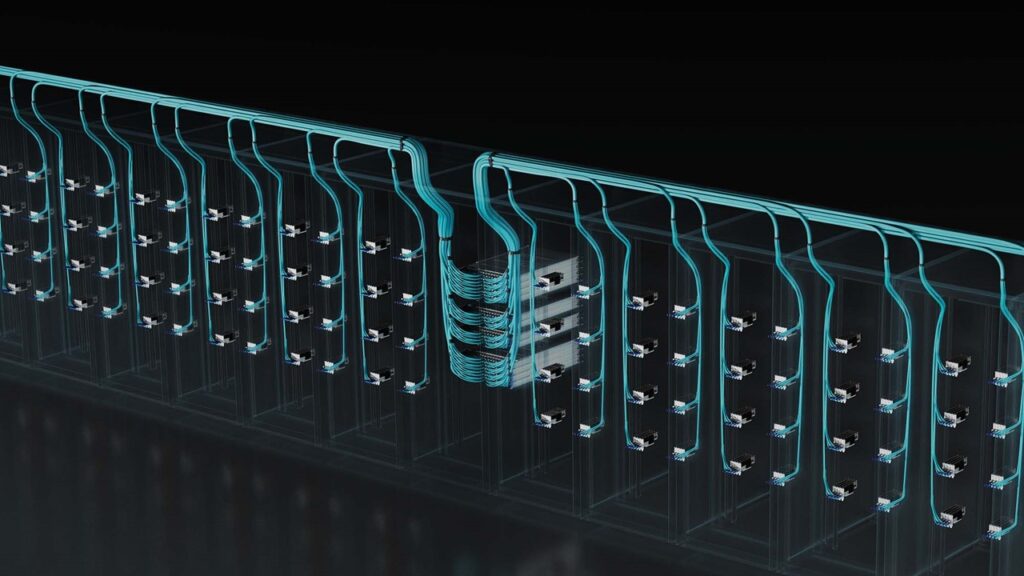 NVIDIA announced NVIDIA Quantum-2, the next generation of its InfiniBand networking platform, which offers the extreme performance, broad accessibility, and strong security needed by cloud computing providers and supercomputing centers.
NVIDIA announced NVIDIA Quantum-2, the next generation of its InfiniBand networking platform, which offers the extreme performance, broad accessibility, and strong security needed by cloud computing providers and supercomputing centers.
The most advanced end-to-end networking platform ever built, NVIDIA Quantum-2 is a 400Gbps InfiniBand networking platform that consists of the NVIDIA Quantum-2 switch, the ConnectX-7 network adapter, the BlueField-3 data processing unit (DPU), and all the software that supports the new architecture.
The introduction of NVIDIA Quantum-2 comes as supercomputing centers are increasingly opening to multitudes of users, many from outside their organizations. At the same time, the world’s cloud service providers are beginning to offer more supercomputing services to their millions of customers.
NVIDIA Quantum-2 includes key features required for demanding workloads running in either arena. Supercharged by cloud-native technologies, it provides high performance with 400 gigabits per second of throughput and advanced multi-tenancy to accommodate many users.
With 400Gbps, NVIDIA Quantum-2 InfiniBand doubles the network speed and triples the number of network ports. It accelerates performance by 3x and reduces the need for data center fabric switches by 6x while cutting data center power consumption and reducing data center space by 7 percent each.
The multi-tenant performance isolation of NVIDIA Quantum-2 keeps the activity of one tenant from disturbing others, utilizing an advanced telemetry-based congestion control system with cloud-native capabilities that ensure reliable throughput, regardless of spikes in users or workload demands.
NVIDIA Quantum-2 SHARPv3 In-Network Computing technology provides 32x more acceleration engines for AI applications compared with the previous generation. Advanced InfiniBand fabric management for data centers, including predictive maintenance, is enabled with the NVIDIA UFM Cyber-AI platform.
A nanosecond-precision timing system integrated into NVIDIA Quantum-2 can synchronize distributed applications, like database processing, helping to reduce the overhead of wait and idle times. This new capability allows cloud data centers to become part of the telecommunications network and host software-defined 5G radio services.
At the heart of the Quantum-2 platform is the new Quantum-2 InfiniBand switch. With 57 billion transistors on 7-nanometer silicon, it is slightly bigger than the NVIDIA A100 GPU with 54 billion transistors.
It features 64 ports at 400Gbps or 128 ports at 200Gbps and will be offered in a variety of switch systems up to 2,048 ports at 400Gbps or 4,096 ports at 200Gbps — more than 5x the switching capability over the previous generation, Quantum-1.
The combined networking speed, switching capability, and scalability are ideal for building the next generation of giant HPC systems.
The NVIDIA Quantum-2 switch is now available from a wide range of leading infrastructure and system vendors around the world, including Atos, DataDirect Networks (DDN), Dell Technologies, Excelero, GIGABYTE, HPE, IBM, Inspur, Lenovo, NEC, Penguin Computing, QCT, Supermicro, VAST Data, and WekaIO.
The NVIDIA Quantum-2 platform provides two networking end-point options, the NVIDIA ConnectX-7 NIC and NVIDIA BlueField-3 DPU InfiniBand.
ConnectX-7, with 8 billion transistors in a 7-nanometer design, doubles the data rate of the world’s current leading HPC networking chip, the NVIDIA ConnectX-6. It also doubles the performance of RDMA, GPUDirect Storage, GPUDirect RDMA, and In-Networking Computing. The ConnectX-7 will sample in January.
BlueField-3 InfiniBand, with 22 billion transistors in a 7-nanometer design, offers sixteen 64-bit Arm CPUs to offload and isolate the data center infrastructure stack. BlueField-3 samples in May.

